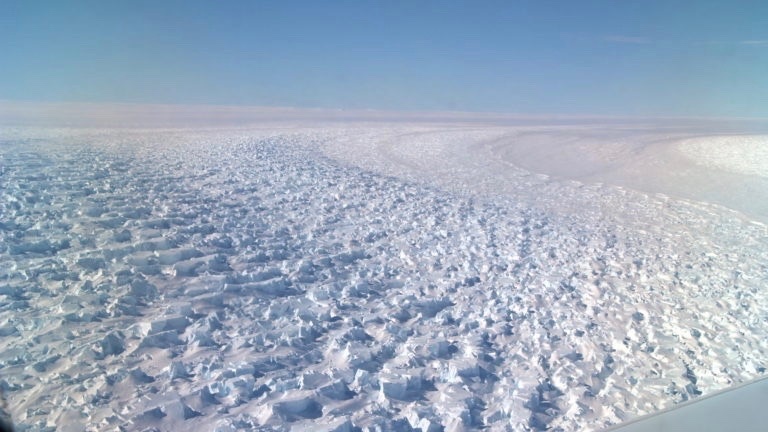

Antarctica's Denman Glacier. NASA
Antarctica‘s Denman Canyon is the deepest gorge on the Earth’s surface, and, if the ice inside it melted, it could raise sea levels by almost five feet.
Now, research published in Geophysical Research Letters Monday looked at how close that might be to happening and found that the glacier had retreated five kilometers (approximately three miles) in the last 22 years, according to a University of California Irvine (UCI) press release.
“If warm water continues to induce high rates of ice melt near the glacier grounding zone, the potential exists for Denman Glacier to undergo a rapid and irreversible retreat, with major consequences for sea level rise,” the researchers concluded.
The study, carried out by scientists at UCI and the National Aeronautics and Space Administration’s (NASA) Jet Propulsion Laboratory, is the most detailed of the glacier to date. It found that it has lost 268 billion tons of ice between 1979 and 2017. It also noticed that the glacier’s grounding line ― the point where the ice begins to flow into the ocean ― had retreated asymmetrically, falling back mostly on the Western side.
BBC News explained why:
The reason, the scientists can now determine, is a buried ridge under the eastern flank which is pinning and protecting that side of the glacier. In contrast, the western flank features a narrow but sizeable trough that would allow warm ocean water to erode the grounding line and push it backwards.
This potentially is an Achilles heel. The further inland the glacier reaches, the deeper its bed – which is a geometry that has been demonstrated to favour more and more melting. If a lot of warm ocean water can find its way to the front of Denman, the opportunity is there to melt out its ice in a significant way.
NASA’s Dr. Virginia Brancato told BBC News it was impossible to say how fast that ice would melt and that the narrowness of the channel that housed the glacier might also slow down its retreat.
“At present, it is critical to collect more data, and closely and more frequently monitor the future evolution of the glacier,” she told BBC News.
The findings also reflect growing concern among researchers about East Antarctica, where the glacier is located. The region is considered more stable than fast-melting West Antarctica, but that is changing.
“East Antarctica has long been thought to be less threatened, but as glaciers such as Denman have come under closer scrutiny by the cryosphere science community, we are now beginning to see evidence of potential marine ice sheet instability in this region,” study co-author and UCI scientist Eric Rignot said in the university release. “The ice in West Antarctica has been melting faster in recent years, but the sheer size of Denman Glacier means that its potential impact on long-term sea level rise is just as significant.”
- Man Swims Under East Antarctic Glacier to Highlight Impacts of the ...
- Antarctic Glacial Melt May Be Irreversible Causing Sea Rise ...
- Earth Has Lost Over 30 Trillion Tons of Ice in Under 30 Years, Scientists 'Stunned' by Landmark Study - EcoWatch
- Climate Crisis Likely Behind Deadly Glacier Collapse in India - EcoWatch
- Climate Crisis Could Rob Liquors of Their Flavor - EcoWatch
- Scientists Identify Tipping Points for Antarctica Glacier

 233k
233k  41k
41k  Subscribe
Subscribe 